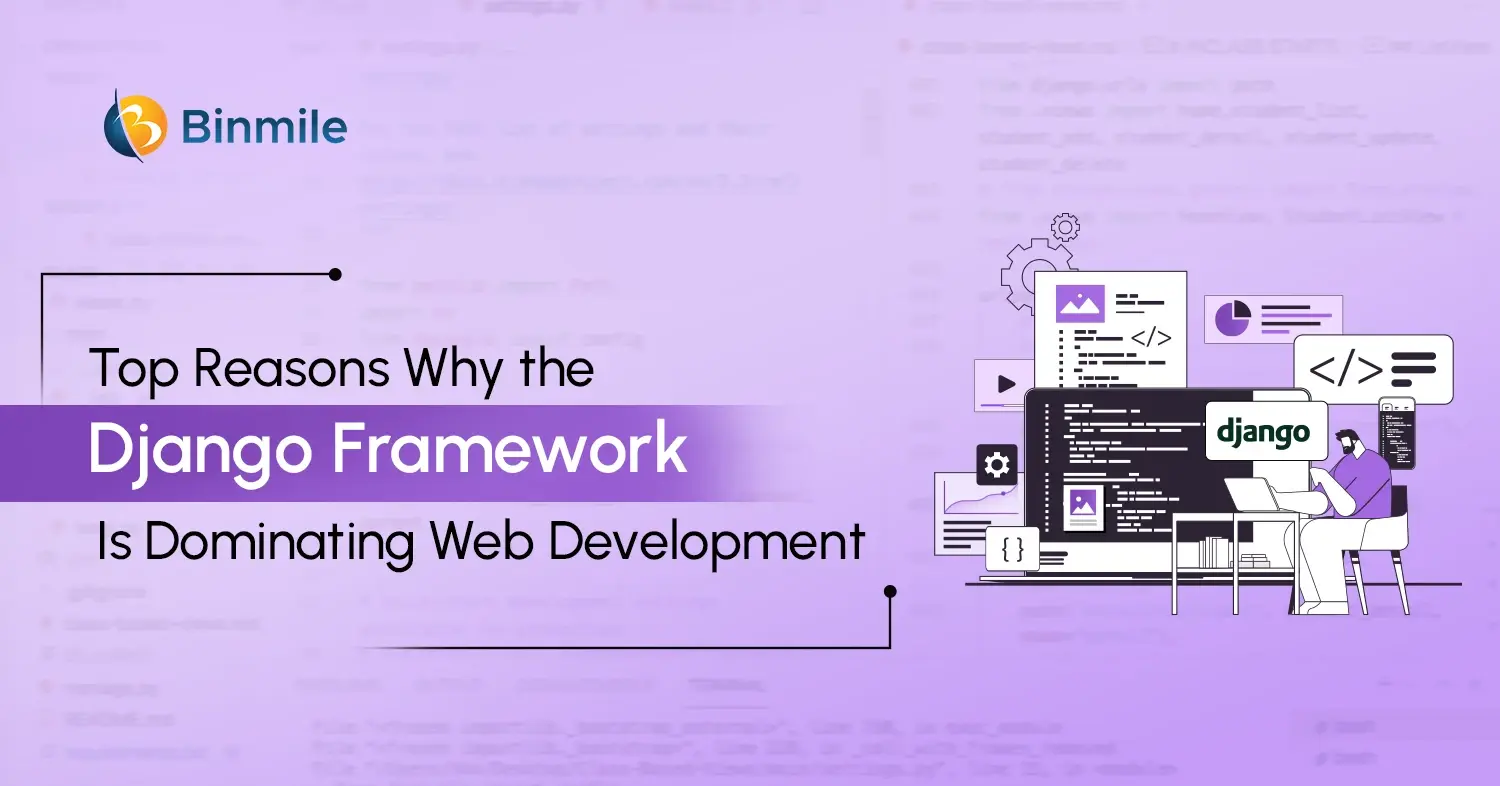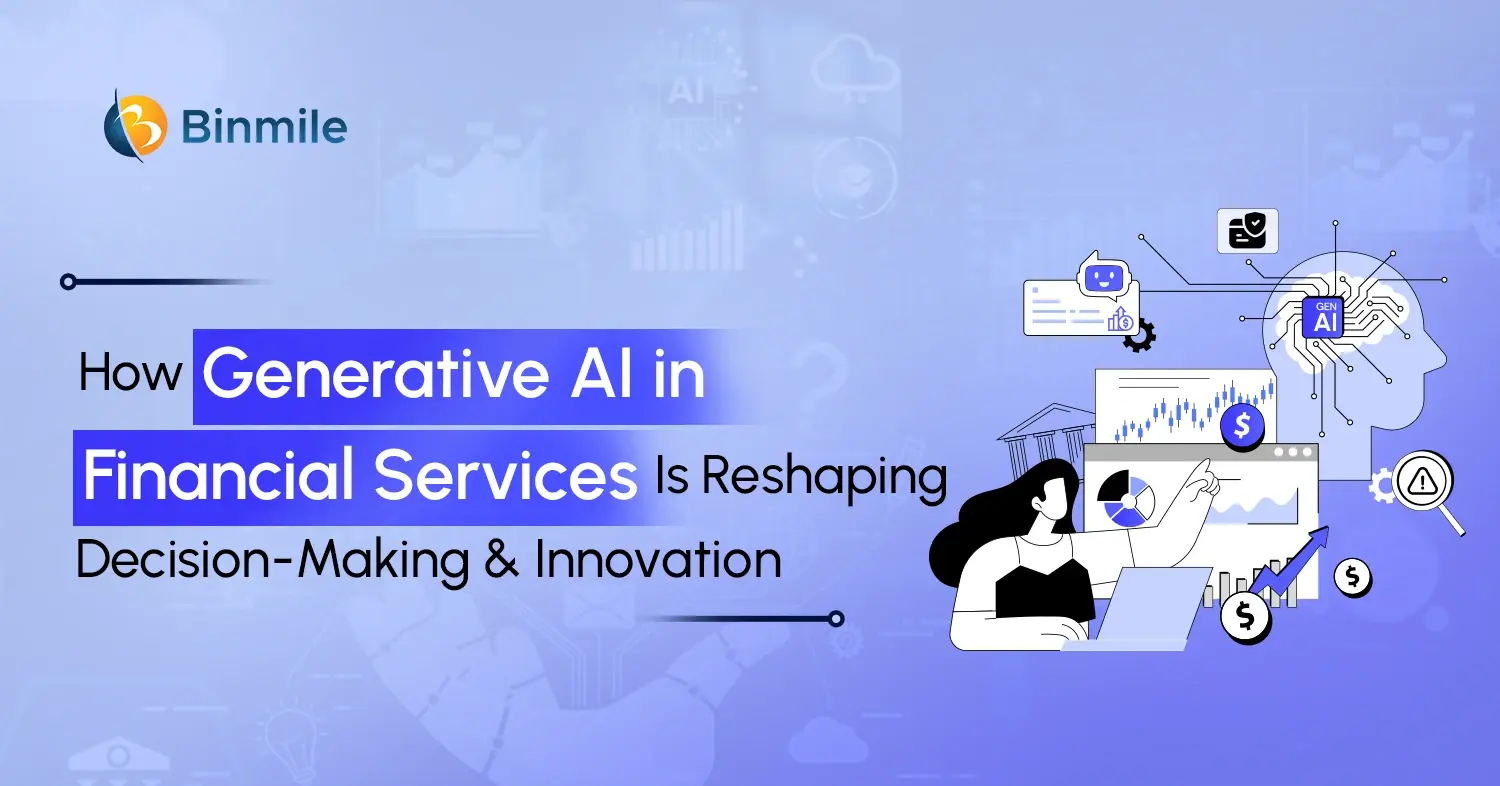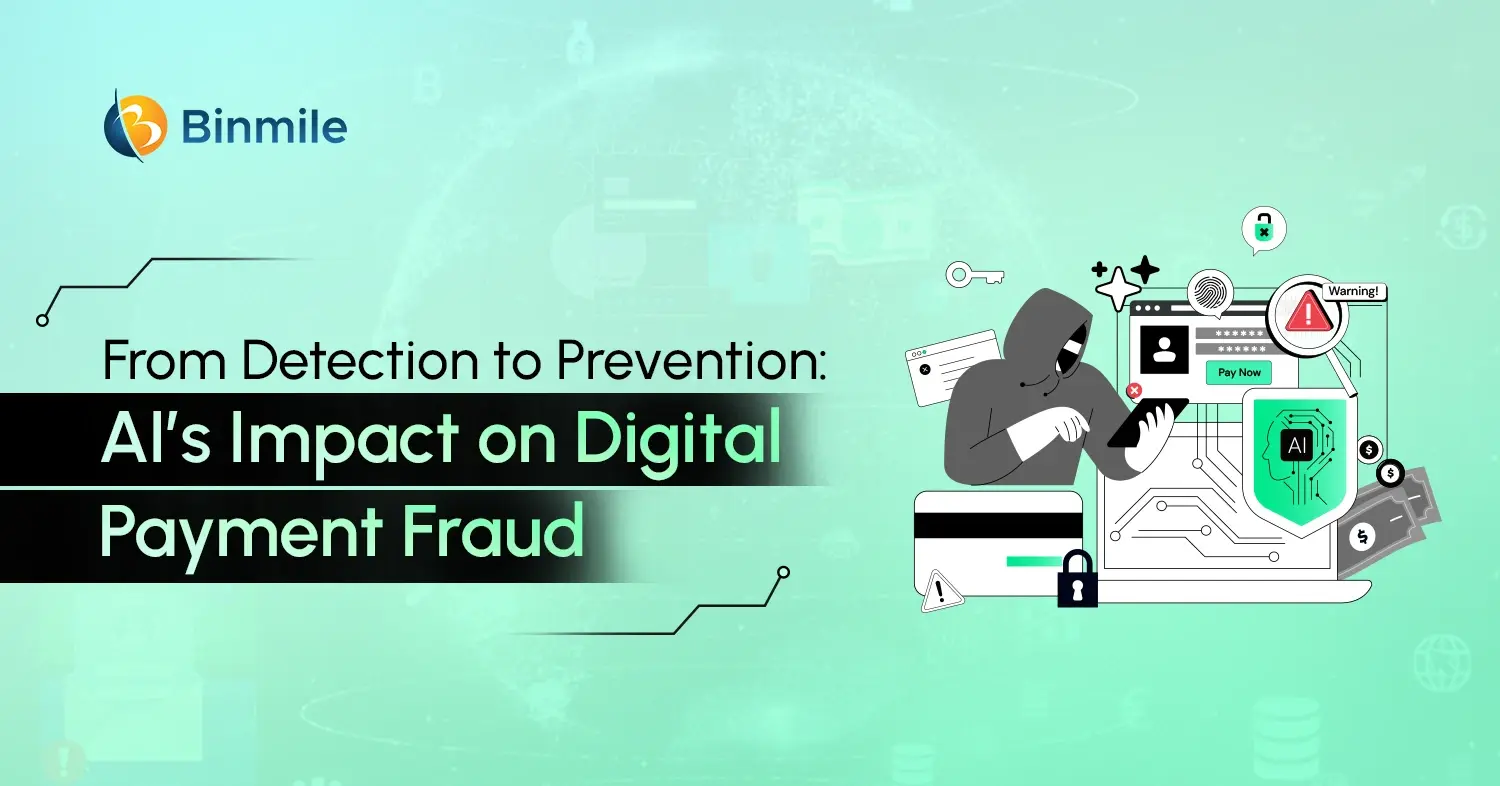What is common among Instagram, Udemy, NASA, Dropbox, and more such websites? All these fast and scalable website backends have been designed and developed using the Django web framework. It has emerged as a high-level Python backend framework that also includes tools to handle frontend aspects as well. This framework stands out with its simplicity and structured approach, enabling businesses to create and manage modern and flexible applications.
By leveraging the Django web framework, businesses can offer enterprise-level features and also build rapid MVPs (Minimum Viable Products). It ensures faster time-to-market and helps deliver maximum value to the end users. So, why is Django the preferred choice for businesses, especially startups? This blog will help you understand the Django web development framework, its top features, pros, cons, and ideal scenarios to utilize it as a backend framework.
Defining the Django Web Framework
Django is a fast, secure, and flexible Python framework that works primarily as a backend web application framework. It also has some frontend capabilities, such as dynamic templates, processing HTML forms, URL routing, etc., which makes it a full-stack framework. According to GitHub, Django is leading with 84.4k stars when compared to Laravel, which follows with 81.7k stars.
The thing that makes Django a popular and high-level framework is its ability to strike the right balance between utilizing enterprise-level features and encouraging rapid mobile application development services. Moreover, it facilitates clean design and structured development of web applications.
Leverage the Key Features of Django Web Framework
When it comes to providing custom web development services, Django web framework services stand out the most and give a competitive edge to other backend frameworks with the following features:
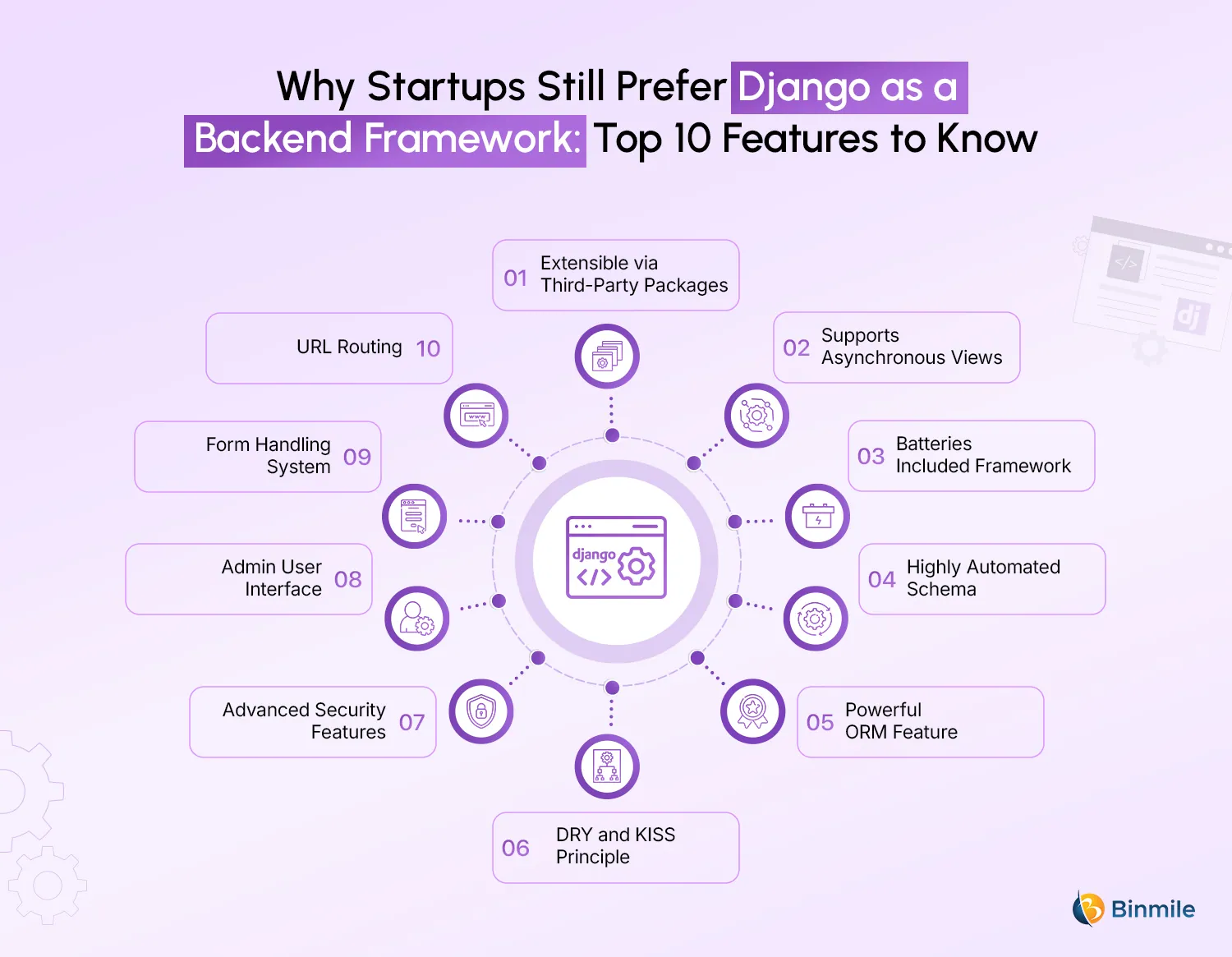
1: Extensible via Third-Party Packages
The Django web framework has an extensive ecosystem of pluggable third-party packages, which helps development teams to add complex functionalities without building them from scratch. There are 4,000+ additional packages available, but out of these, one of the best and most popular third-party packages is:
Django REST Framework: This 3rd-party package is a flexible toolkit that is used to streamline the process of creating a REST API. It has serialization capability, which helps in supporting both ORM and non-ORM information sources.
2: Supports Asynchronous Views
After the launch of the Django 3.1 version, Django now also supports async views. Asynchronous views refer to view functions defined using Python syntax that enable the handling of input/output operations without blocking the execution process. This capability is much needed and makes it suitable for the development of modern websites that need real-time performance optimization, such as chat apps.
3: Batteries Included Framework
Django is called a “Batteries Included” framework, as it comes with numerous built-in tools and libraries. The Django web development framework feature allows development teams to focus on core business operations rather than spending their time on integrating other third-party tools. Some of the built-in tools and libraries are:
- Templating Engine
- Admin UI Interface
- URL Routing
- Form Handling System
- User Authentication & Authorization
- Caching Framework
- Session Management
- Security Features
4: Highly Automated Schema
The Django web framework includes a phenomenal migration engine that allows development teams to make highly automated schema changes in the database. This is done by defining the data models, each model representing the structure of the database that needs to be changed. Whenever a change is made in the model, it automatically generates a migration Python file that has the schema changes.
Now, developers can update the actual database schema by executing the migration file. This framework ensures consistency by having a record of migrations that are executed.
5: Powerful ORM Feature
An object-relational mapper (ORM) is a functional feature in the Django web framework that helps development teams to interact with relational database tables using Python objects and functions. By eliminating the need for writing SQL queries, it helps developers handle the databases quickly with speed. This is because teams can manipulate data, switch, and transfer the data between multiple databases with fewer Python code lines.
This ORM feature simplifies database operations and provides more consistent and reliable access to modify and change the data.
6: DRY and KISS Principle
The Django web framework follows both the DRY (Don’t Repeat Yourself) and KISS (Keep It Short and Simple) principles.
- DRY Principle: In this, developer teams don’t need to create the repetitive LOC (lines of code) everywhere the same functionality is needed. Instead, it promotes reusability and reduces redundancy in code by enabling teams to create a package for the repetitive and common code. The package can be a reusable component in the form of a function, class, template, or library.
- KISS Principle: This principle focuses on writing the code logic in a straightforward and structured way. This means that developers don’t need to overly complicate the coding logic, and the code should not exceed more than 30-40 lines. Additionally, if it is a complex code, then break it down into smaller and more manageable functions.
7: Advanced Security Features
The Django web framework offers a powerful set of built-in security features, helping teams build applications that provide protection against security attacks and potential vulnerabilities. The top 3 important security features embedded in Django are:
- SQL Injection: Django’s ORM feature ensures that the databases remain safe by using parameterized data queries. This allows teams to insert data as parameters rather than concatenating directly into SQL statements.
- Cross-Site Scripting (XSS): To ensure that no malicious code is injected into the codebase, it automatically escapes content in templates and prevents XSS attacks.
- Clickjacking Protection: Provides a middleware mechanism to protect websites from embedding the codebase in a malicious page using iframes.
8: Admin User Interface
Django offers a powerful admin interface that can be automatically generated based on the type of application for managing the data efficiently. This feature can be customized by adding more actions or tasks, such as creating, updating, or deleting any unused records, according to the specific requirements.
Additionally, this built-in functionality allows teams to have an access-based control system that can manage the access requests and authorize permissions to specific user roles. In this way, development teams can protect their sensitive data and its transactions.
9: Form Handling System
The Django web framework helps teams to build applications that come with a built-in form class. This includes validation and security features for protecting the application against any CSRF (Cross-Site Request Forgery) attacks. By integrating Django as a backend framework, teams can have access to these forms and generate error messages whenever an invalid form input is added, resulting in a seamless user experience.
10: URL Routing
Django’s URL Routing feature is one of the core features, as it ensures that the incoming requests are directly mapped to views. This helps teams to design clean URLs so that they can maintain them easily. By leveraging this feature, development teams can also use namespaces.
For example, if the team is building a shopping app, the namespace can be shop:detail. This can be used to avoid conflicts regarding the names of different apps in the same project.
Want to leverage Django for your next web application to accelerate the development process and increase ROIs?

Django Web Development Framework: Pros, Cons & Ideal Scenarios to Use
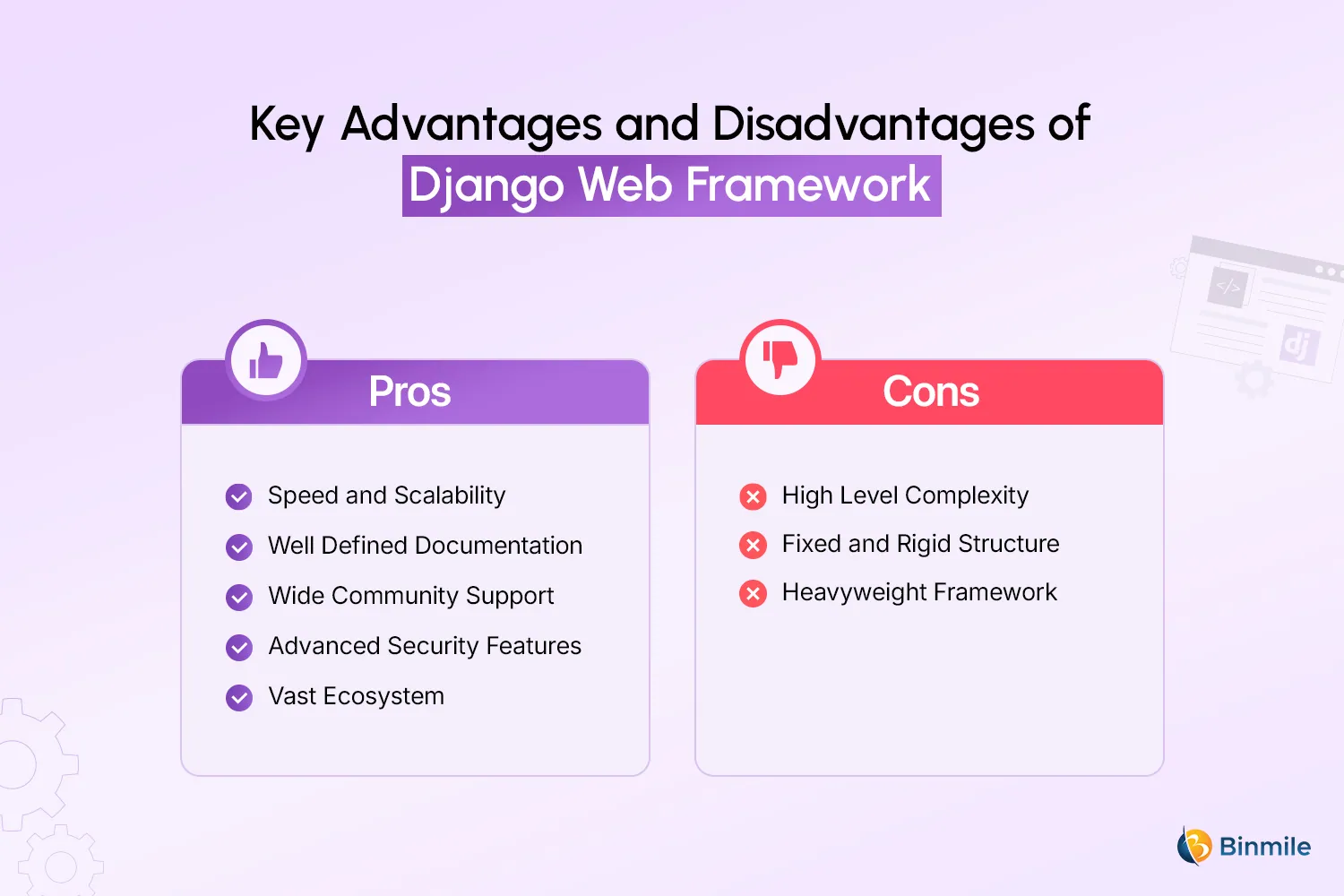
Pros of Django Web Framework
- Speed and Scalability: It offers enhanced scalability and faster development and deployment cycles that allow teams to build MVPs and enterprise-level applications.
- Well Defined Documentation: It has high-quality, well-structured, and extremely detailed documentation, which can be helpful for beginners who are just starting their Django web framework journey.
- Wide Community Support: It is backed up by a mature and active community of experienced developers, where experts offer blogs and knowledgeable tutorials to help and support new beginners learn Django.
- Advanced Security Features: It comes with pre-built security features that can help prevent the application from any type of threats. These features include SQL injection, XSS protection, CSRF protection, and more.
- Vast Ecosystem: It is known for its integration capabilities with third-party apps and add-on libraries that help build robust backend, data manipulation, and cloud computing functionalities.
Cons of Django Web Framework
- High Level Complexity: While it comes with powerful features, it can be a little complicated for beginners or for building small projects that don’t need extensive web development tools.
- Fixed and Rigid Structure: It follows a fixed structure with predefined conditions for building web applications, which can sometimes be restrictive when building a flexible app that has evolving business requirements.
- Heavyweight Framework: It is a resource-intensive web application framework that can add unnecessary overhead costs and increase the overall development costs.
When to Utilize the Django Web Framework
The Django web framework is widely known for its versatility, and many companies rely on and use Django for their crucial business operations. Here are some of the scenarios where it is the ideal fit:
- Creating and managing rapid MVPs (Minimum Viable Product) with core features
- Requiring advanced analysis features for the personal data of financial platforms
- Managing enterprise software development where the speed and scalability are crucial factors
- Building data-driven and intensive applications for supporting AI and machine learning capabilities
- Modernizing legacy apps by integrating serverless computing to provide cost-effective solutions
Build scalable and secure applications by integrating Django within your existing technology stacks to enhance the development cycles and build a high-quality product.

Closing Remarks on Django Web Development Framework
There are several server-side or backend frameworks in this competitive market, but selecting the right one is a complicated and intricate task. Business enterprises should always choose a framework that can effectively fit and align with their business goals and requirements. When it comes to back-end development, Django emerges as the best and high-end web framework option. It’s a battery-included approach to web development, which helps businesses to reduce their development costs and time significantly.
Leveraging Django as the backend development framework, businesses can easily meet the scalable and evolving demands, as it is well-designed to manage and handle high user-load traffic. This blog has covered the top 6 features, pros, cons, and ideal scenarios to use the Django web framework. We have also discussed and gotten to know why the Django web development framework stands out the most and is popular for startups. If you need a correct roadmap to build custom web apps, consulting a Python development company can help you in this, resulting in achieving maximum growth.
